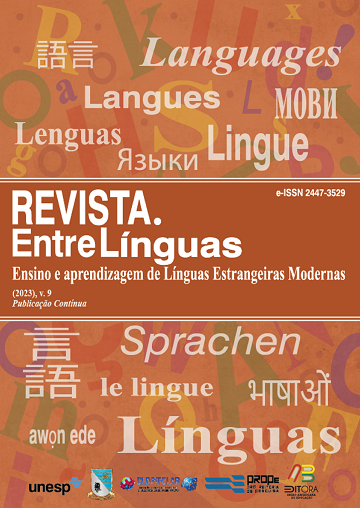Educational technology and principles and methods of teaching english
DOI:
https://doi.org/10.29051/el.v9i00.17747Keywords:
Educational technology, Quality improvement, English, Traditional educationAbstract
The teaching aids as an interface have been able to play their role well. It will be better if teachers have the necessary skills to use these tools. Today, experts and thinkers around the world emphasize the importance and determining the role of educational technology in the learning process and believe that the optimal use of teaching aids instead of teachers will have a constructive effect on improving the quality of education. Due to our country's educational system's problems in teaching English and the lack of skills of trained students, especially in speaking, listening, and writing, many parents try to cover this shortage in the educational system by resorting to advanced schools. Thus, in this article, we decided to examine the role of teaching assistive technologies in facilitating English language teaching in classrooms.
Downloads
References
ATKINS, N. E.; VASU, E. S. Measuring knowledge of technology usage and stages of concern about computing: A study of middle school teachers. Journal of Technology and Teacher Education, v. 8, n. 4, p. 279-302, 2000.
EGBERT, J. L.; PAULUS, T. M.; NAKAMICHI, Y. The impact of CALL instruction on classroom computer use: A foundation for rethinking technology in teacher education. Language Learning & Technology, v. 6, 2002.
FETSCO, T.; MC CLURE, J. Educational psychology. New York: Allyn and Bacon, 2005.
HANSON-SMITH, E. Classroom practice: Using multimedia for input and interaction in CALL environments. In: HANSON-SMITH, E. (Ed.). CALL environments: Research, practice, and critical issues. Alexandria, VA: TESOL, 1999. p. 189-215.
HOFSTETER, F. T. Multimedia literacy. NY: MC Grow – Hill, 1996.
JOHNSON, D.; EISENBERG, M. Learning and Teaching Information Technology Computer Skills in Context. ERIC Digest, 2006.
JONES, J. E. Computer Simulated Experiments in High School Physics and chemistry. 1972. 127 f. Dissertation (Doctorate) – Iowa State University, 1972.
KIM, H. Teachers as a barrier to technology-integrated language teaching. English Teaching, v. 57, n. 2, p. 35-64, 2002.
KULIK, J. A.; BANGART, R. L.; WILLIAMS, G. W. Effects of Computer Based Learning on Secondary School Students. Journal of Educational Psychology, v. 75, p. 12-26, 1983.
LABORDA, J. G.; ROYO, T. M. Educational Technology & Society, v. 10, n. 3, p. 320-324, 2007.
LAM, Y. Technophiliacs, technophobia: A preliminary look at why secondlanguage teachers do or do not use technology in their classrooms. Canadian Modem Language Review, v. 56, n. 3, p. 389-420, 2000.
MORGIL, I. et al. Traditional and computer – assisted learning in teaching acid and bases. Chemical Education Research and Practice (CERP), v. 6, n. 2, p. 52- 63, 2005.
ORTIZ, A. English language learning with special needs; Effective instructional strategies. Journal of Learning Disabilities, v. 30, p. 420-321, 2007.
PARK, C.; SON, J.-B. Implementing Computer-Assisted Language Learning in the EFL Classroom: Teachers’ Perceptions and Perspectives. International Journal of Pedagogies and Learning, v. 5, n. 2, p. 80-101, 2009.
REAMON, D. T.; SHEPPARD, S. D. The role of simulation software in an ideal learning environment. In: DESIGN ENGINEERING TECHNICAL CONFERENCES, 1997, Sacramento. Proceedings […]. Sacramento, CA, 1997.
SCHACTER, J. The Impact of Educational Technology on Student Achievement: What the Most Current Research Has to Say. ERIC Digest, 1999.
SHIN, H.-J.; SON, J.-B. EFL teachers' perceptions and perspectives on Internetassisted language teaching. CALL-EJ Online, v. 8, n. 2, p. 14-31, 2007.
SWAIN, N. K.; ANDERSON, J. A.; KORRAPATI, R. B. Role of simulation software in enhancing student learning in computer organization and microcontroller courses. In: INTERNATIONAL CONFERENCE, 2008, Nashville. Proceedings […]. Nashville, TN, USA, 2008. Available: http://www.ijme. us/cd_08/PDF/135%20ENT%20207.pdf. Access: 10 Jan. 2022.
WENGLINSKY, H. The Relationship Between Educational Technology and Student Achievement in Mathematics: Educational Testing Service Policy Information CenterSteed. Marlo & Marzek, Rick 1999.
WOOLFOLK, A. E. Educational psychology. Boston: Allyn Bacon, 2001.
Published
How to Cite
Issue
Section
License

This work is licensed under a Creative Commons Attribution-NonCommercial-ShareAlike 4.0 International License.
Os manuscritos aceitos e publicados são de propriedade da Revista EntreLínguas. Os artigos publicados e as referências citadas na Revista EntreLínguas são de inteira responsabilidade de seus autores.
Transferência de direitos autorais – autorização para publicação
Caso o artigo submetido seja aprovado para publicação, já fica acordado que o(s) autor(es) autoriza(m) a UNESP a reproduzi-lo e publicá-lo na EntreLínguas, entendendo-se os termos “reprodução” e “publicação” conforme definição respectivamente dos incisos VI e I do artigo 5° da Lei 9610/98. O artigo poderá ser acessado pela rede mundial de computadores (Internet), sendo permitidas, a título gratuito, a consulta e a reprodução de exemplar do artigo para uso próprio de quem a consulta, desde que haja a citação ao texto consultado. Essa autorização de publicação 328 EntreLínguas, Araraquara, v. 1, n .2, p. 323-328, jul./dez. 2015 não tem limitação de tempo, ficando a UNESP responsável pela manutenção da identificação do(s) autor(es) do artigo. Os artigos publicados e as referências citadas na Revista EntreLínguas são de inteira responsabilidade de seus autores.











